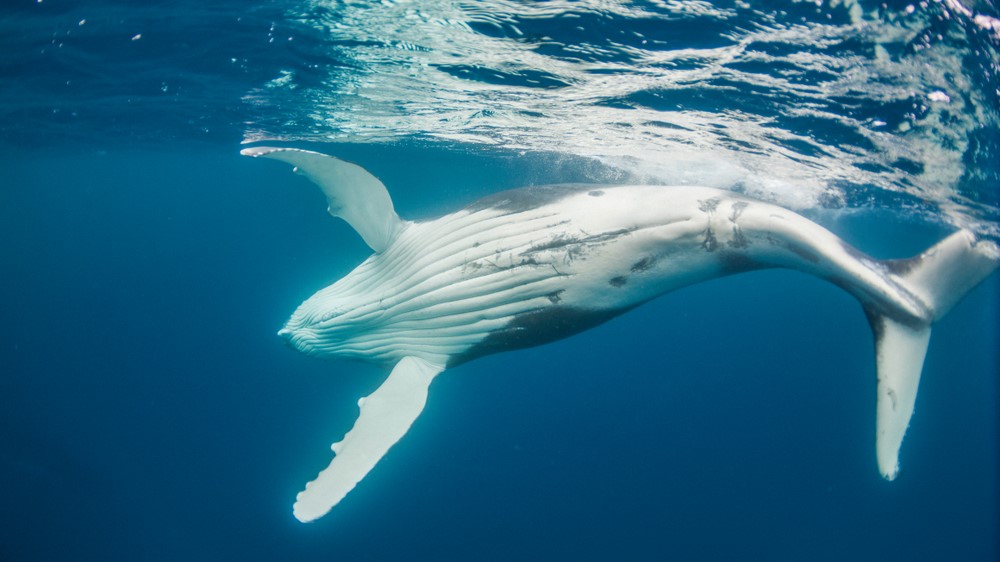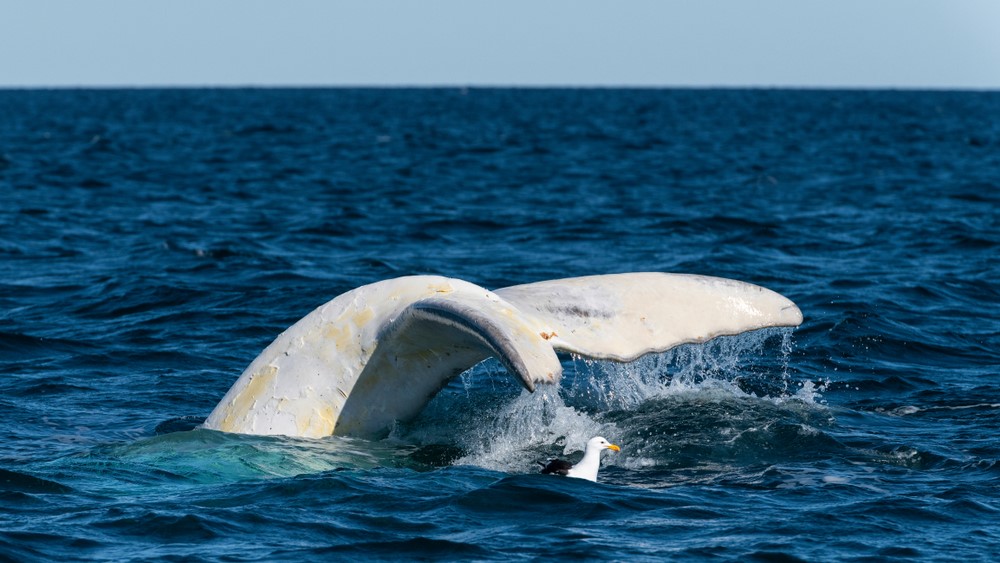Rare white humpback whale spotted swimming with dolphins Down Under
Video of the ghostly cetacean was captured by a local teenager using a drone.

An extremely rare white humpback whale has been spotted frolicking with a pod of dolphins near the Australian coastline, according to aerial video footage. And it may have a rather famous relative.
The ghostly cetacean was spotted on April 21 around 1,640 feet (500 meters) off the coast of Fingal Head in New South Wales. The humpback whale (Megaptera novaeangliae) was first noticed by 16-year-old local Brayden Blake, who was surfing at the time; when Blake fell off his board, he heard the whale's song underwater. After returning to the beach, Blake spotted the white whale almost immediately and ran home to get a camera-carrying drone. The young surfer then managed to capture video footage of the humpback swimming with a pod of dolphins.
"I've seen regular humpback whales before, but this one didn't look at all the same," Blake told The Guardian. "Every time it came back for a breath of air, it was white" instead of black or dark gray like other humpbacks. The white whale eventually disappeared after around 20 minutes when it dove into the ocean depths. The encounter was a "once in a lifetime" experience, Blake added.
Blake's white whale resembles the famous Migaloo, a male albino humpback that was first spotted in Queensland, Australia in 1981. However, the new whale is smaller than Migaloo and has patches of gray coloration, while Migaloo was completely white. Experts therefore suspect that this is most likely a second white humpback from the same population. (Migaloo means "white fella" in the language of the Aboriginal community living near where the albino whale was discovered).
"This is the first time that I've been able to say that the white whale I'm looking at could be a white whale other than Migaloo," Wally Franklin, a marine ecologist at Southern Cross University in Australia who has studied Migaloo since 1982, told Australian newsite Nine News. "It's an incredibly rare occurrence."
Related: 7 oddly colored animals that caught our eye in 2021
The sighting of a second white whale, which scientists believe is likely a young male, has sparked speculation online that the new humpback might be Migaloo's son or another close relative.
Sign up for the Live Science daily newsletter now
Get the world’s most fascinating discoveries delivered straight to your inbox.
This population of humpback whales migrates through Australian waters between May and November before returning south to Antarctica to feed on krill. People have spotted Migaloo between late June and early July almost every year since he was first observed, according to Nine News. However, researchers suspect that younger males may be the first to start the annual migrations, which would explain this newly noticed whale's appearance in April.
"The timing of the sighting is consistent with it being a younger whale because it's still very early in the season," Franklin told Nine News, and this whale's young age could support the idea that this is Migaloo's son, as this type of white coloring is largely genetic. There is a good chance that the new white humpback could be spotted again and properly photographed before the year's migration season ends, which could shed light on the relatedness between the two individuals based on comparisons of their fin and tail shapes, he added.

However, not everyone is convinced the new white humpback is related to Migaloo. The main reason for this is the patchy white coloration on the humpback's skin, Vanessa Pirotta, a wildlife scientist at Macquarie University in Australia who specializes in cetaceans, told The Guardian. "It makes me think it’s not albino," which suggests that the two whales are unrelated, she said.
White coloration in whales can be caused by two separate conditions: albinism and leucism. Migaloo has albinism, which means that he is genetically incapable of producing melanin, a pigment responsible for skin, hair and eye color. Albinism can also cause animals to have red eyes and may affect their ability to see properly. However, the new white humpback has patches of gray skin, suggesting that it has leucism, which instead affects individual pigment cells' ability to produce melanin rather than preventing cells from producing pigment at all.
Albinism and leucism are "extremely rare" among whales and they are likely to affect fewer than 1 in 10,000 humpback individuals, Erich Hoyt, a research fellow at Whale and Dolphin Conservation (WDC) in the U.K. and author of several books on cetaceans, told Live Science in an email. In other animal groups, these conditions can dramatically affect an individual's chances for survival. However, that is typically not the case in cetaceans, he added.
"In species where sight is important for hunting (birds, land mammals, etc.) and where white individuals stand out to predators, the white individuals die young and don’t often come close to maturity and reproduction," Hoyt said. "By contrast, whales can use their acoustic senses to feed even in the dark or at night and have few if any predators."
Albinism is caused by a recessive gene and has been known to be passed onto offspring from parents in captivity through selective breeding. In 2021, a pair of albino crocodiles were born from albino parents in a safari park in Florida, Live Science previously reported. However, it is less clear if the genes which cause albinism could also cause leucism in offspring that did not inherit albinism, which is what would have had to have happened if this new whale is indeed related to Migaloo.
Even if the two conditions are not directly linked, it is possible that an albino parent like Migaloo could randomly pass on leucistic genes to its offspring like any other normally colored individual, Hoyt wrote. "But I suspect this is so rare that there aren't many examples," he added.
Unfortunately, being able to confirm if the two white humpbacks are actually related is challenging. There are now thought to be more than 40,000 individuals in Australia's humpback whale population, according to Nine News. This makes determining genetic relationships between individuals tricky, even if they are both white, Pirotta told The Guardian.
The only way to tell if the two individuals are related would be to take a genetic sample, such as tissue or poop, from the newfound white whale. In 2004, researchers were able to obtain a genetic sample from Migaloo, which has since been used in several studies, according to the Pacific Whale Foundation, a nonprofit based in Hawaii. If scientists were able to collect a genetic sample from the newly spotted white humpback they might be able to settle the debate. But for now it remains a mystery.
Originally published on Live Science.

Harry is a U.K.-based senior staff writer at Live Science. He studied marine biology at the University of Exeter before training to become a journalist. He covers a wide range of topics including space exploration, planetary science, space weather, climate change, animal behavior and paleontology. His recent work on the solar maximum won "best space submission" at the 2024 Aerospace Media Awards and was shortlisted in the "top scoop" category at the NCTJ Awards for Excellence in 2023. He also writes Live Science's weekly Earth from space series.










